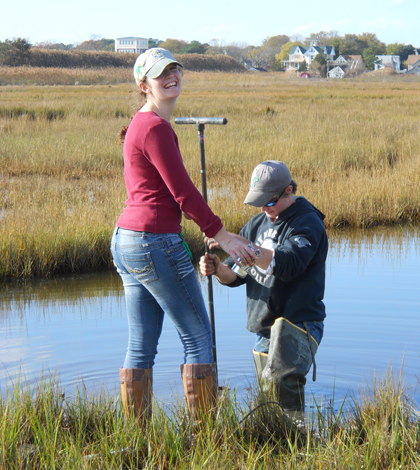Pennsylvania students and Chincoteague Bay Field Station team up to monitor, restore coastal ecosystem

Shippensburg University students installed monitoring wells at the Chincoteague Bay Field Station (Credit: Chincoteague Bay Field Station)
Students and faculty from Shippensburg University are teaming up with residents of Chincoteague, Va. to promote community interaction and improve the region’s shoreline.
A $64,000 TogetherGreen Grant from Toyota and the National Audubon Society will fund the Living Shore project, which includes the removal of invasive plant species, water monitoring and the installation of oyster castles. The grant was awarded to the Chincoteague Bay Field Station, a Marine Science Consortium facility that promotes hands-on education and environmental stewardship.
“The overall goal is that we’re building communities,” said Anne Armstrong, education director at the Field Station. “We’re building an oyster community, we’re building a new marsh community, and we’re building human communities.”
Armstrong obtained the grant with the help of Sean Cornell, an associate professor of Shippensburg’s Geography and Earth Science department. Cornell said that applying for the TogetherGreen grant was a no-brainer.
“They’re looking for the sort of community-embedded projects that help integrate community into environmental initiatives,” Cornell said. “This program sort of popped out there as a great match for what we wanted to do.”
The community integration comes in to play through a program called SPARK, which stands for Shore People Advancing Readiness for Knowledge. Designed for families with young children, the program seeks to educate participants about the environment while facilitating outdoor fun.
Kids in SPARK receive educational packets each week at school. They work with their parents on the packets and go on monthly nature trips, such as woods walks or farm visits. Out of the 150 current members of SPARK, five families will spend the next year working alongside students and faculty from Shippensburg University on the Living Shore project.

University students with SPARK participants and project coordinator Anne Armstrong (Credit: Chincoteague Bay Field Station)
One part of the project entails the restoration of an impaired saltwater wetland. The wetland was stricken by thermal pollution and an infestation of phragmites australis, an invasive species also known as Eurasian marsh grass.
“It’s nasty stuff,” Cornell said. “It’s got such an intensive root network…it also releases a chemical that inhibits the root propagation of native species.” These qualities allow the plant to crowd out the native species that help maintain the quality of water and soil in the wetland.
SPARK members and university personnel will remove the phragmites and channel parts of the marsh to reestablish tidal flow, Armstrong said. Additionally, they will be responsible for testing water and atmospheric quality at three monitoring wells once per month.
The wells use Solinst Levelogger Juniors to measure water temperature, water elevation and conductivity, and Solinst Barologgers to measure barometric pressure in the atmosphere. Onset HOBO Data Loggers will soon be installed to measure dissolved oxygen levels. The instruments take measurements every 15 minutes and synchronize with an intercoastal observation network.
“We’re very conscious of sea level rise in this region. Long term data on water level in a specific area will give us data on sea level rise,” Armstrong said, explaining the importance of monitoring water level. She added that the data also contributes to the restoration process.

Shippensburg University student with installed monitoring well (Credit: Chincoteague Bay Field Station)
SPARK members will also have the opportunity to install oyster castles along the bay coastline.
The oyster castles, which Armstrong described as “cement Lego blocks,” provide young oysters with a place to settle. In turn, the oyster settlements help slow the rate of shoreline loss due to weather erosion.
University students have helped to track the erosion since 2011, by mapping the shoreline with GIS devices. According to Cornell, weather events like Hurricane Irene contribute to the importance of taking shoreline measurements.
“In some places we’ve lost as much as 18 or 20 feet of shoreline,” he said. “When you’re a property owner, losing that much ground in just two storms is pretty significant.”
The TogetherGreen grant will fund the Living Shore project until autumn 2014. Families in the SPARK program will begin checking the monitoring wells in January of that year.
“We have to get students in the field, get their feet wet, really show them… this is what’s happening in the environment,” Cornell said. “Don’t let them take it secondhand from somebody.”
“Everybody can be part of this process,” he said.




0 comments